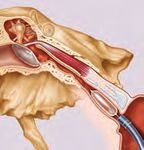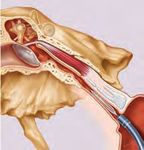TubaVent The first causative therapy for tube dysfunction
←
→
Page content transcription
If your browser does not render page correctly, please read the page content below
TubaVent ®
The first causative therapy for tube dysfunction
GmbH
Burghof 14
51491 Overath / G ermany
PO Box 3403, Erina NSW 2250,
Tel.: +49 Australia
(0) 2206 / 90 81 - 0
P +61 2 9810 6947 F Fax:
+61+49 2 8072
(0) 22061556
/ 90 81 -13
admin@coremed.com.auexport@sp iggle- theis.c om
www.coremed.com.au
www.sp iggle- theis.c omNew therapy concept in the treatment of chronic tube ventilation disorders
“The use of microscopic and endoscopic technologies has Tuba Eustachii,
revolutionised medicine and is state of the art today. With the pars ossea
development of balloon catheters, for example for the dilata- Tuba Eustachii,
tion of heart coronaries, previously inconceivable revolutiona- pars cartilaginea
ry treatment concepts emerged. The transfer of this technology
to the dilatation of the auditory tube provides the possibility Torus
tubarius
infections.
Particularly for chronic tube dysfunctions or middle ear
pathologies, there is now the opportunity to therapeutically
Prof. Dr. med. Holger Sudhoff, FRCS
approach the black box of otolaryngology. The new treatment
Musculus tensor
(Lon), FRCPath
Senior consultant of the Klinikum veli palatini
Bielefeld (Ear, nose and throat, head chronic tube dysfunction and to provide our patients with a new
and neck surgery clinic, Bielefeld treatment possibility for this previously untreatable condition.“
medical centre)
Cause of tube ventilation disorders Principle
Chronic recurring infections of balloon
Allergies dilatation
Laryngopharyngeal reflux
Inflammatory disorder of the mucosa
Anatomically caused obstruction
Adenoid vegetations, e.g. “polyps“ Inserting the Dilating the
Glue Tube catheter auditory tube
TubaVent ® short Balloon catheter with olive
The catheter was optimally adapted to the single use insertion instrument and equipped with an especially rounded tip.
The catheter dimensions were perfectly adapted to the length of the single use insertion instrument,
An olive-shaped tip ensures enhanced protection of the mucosa, especially in children.
TubaVent ® short
Balloon catheter for Tuba Eustachii, WL 236 mm, balloon 3.28 x 20 mm, sterile
2080-1236320
Inflation pump
In
Single-use
20 ml syringe with detachable plunger using command switch, twist grip,
pressure gauge and high-pressure connection using Luer Lock rotary adapter
Division from 0 to 30 atm, PSI scale
Includes 100 cm - extension tube 2080-9030020TubaInsert ®
The well-known reliability of the sterilisable combined insertion instrument applies to the single use insertion
instrument as well. The single use insertion instrument was developed based on experience and in close cooperation
with its users.
“The new TubaInsert ®
of a sucker and an insertion aid. The smaller disposable insertion instrument offers improved functionality
and better handling particularly in children, and allows a more direct contact with the patient.”
Prof. Dr. Matthias Tisch
Honorary Doctorate in Medicine
Jordan University of Science and Technology (JUST)
Clinical Director, Clinic for Otolaryngology, Head and Neck Surgery
Bundeswehr Hospital, Ulm, Germany
Single use insertion instrument
Improved handling due to a shorter insertion distance in case of narrow anatomic conditions,
for example in children
Four different geometries matching any anatomy are offered
Optimal ergonomics and a serrated surface allow comfortable and safe handling
Compatible in length with TubaVent ® short
The single use insertion instrument allows for doing without lengthy treatment processes after use
2080-2045 Type 45°, sterile, 10 pieces/box, short curve
2080-2070 Type 70°, sterile, 10 pieces/box
GmbH
Burghof 14
51491 Overath / Germany
Tel.: +49 (0) 2206 / 90 81 - 0
Fax: +49 (0) 2206 / 90 81 -13
info@spiggle-theis.de
www.spiggle-theis.de
www.spiggle-theis.com
© 2015 by Spiggle & Theis Medizintechnik GmbH
Please note that due to production, the dimensions of the products may vary slightly
to those stated. Please note also that not all goods might be for sale in your country.Publ icat ion s M. Tisch, H. Maier, H. Sudho , ACTA Othorhinolaryngologica Italica 2017 Clinical experience in the management of children. Treatment of Eustachian tube dysfunction. Subjects: 126 children, range 28 months to 13 years. Preoperative Examination: Clinical Examination, Tympanometry with Eustachian tube dysfunction, who had previously not responded to other treatments. No intra- or postoperative complications. Result: clinical symptoms improved in more than 80% of patients. No patient reported a deterioration. Williams, B. et al., Balloon dilation of the eustachian tube: a tympanometric outcomes analysis; Journal of Otolaryngology - Head and Neck Surgery 2016 Documentation of 18 patients, 25 tubes Period: February 2010 to February 2014 Pre-operative examination: Tympanometry Post-operative checks after: 2-3, 6-9, 12-15 months Result: Overall 36 % of ears had improvement in tympanogram type, and 32 % had normalization of tympanogram post-operatively. The Jerger tympanogram values up to 15 months post-operatively. One year follow-up study; American Journal of Otolaryngology 2016 Documentation of 40 patients, 58 tubes Period: April 2013 to November 2014 Pre-operative examination: clinical examination, audiometry, tympanometry, Valsalva, ear microscopy, TMM, ETS Post-operative checks after: 1 week, 3 and 12 months Result: and the ability to perform a Valsalva maneuver 1 week, 3 months and 12 month postoperatively. Subjective symptoms were not relieved only in one patient. The overall success rate for all patients was 98%. Schröder, S. et al., Balloon Eustachian tuboplasty: a retrospective cohort study; Clinical Otolarnygology 2015 Documentation of 622 patients, 1076 tubes Period: February 2009 to February 2014 Pre-operative examination: clinical examination, audiometry, tympanometry, Valsalva, Toynbee test, TMM, ETDQ score, ETS Post-operative checks after: 1 year, 2, 3, 4 and 5 years Result: One year after treatment, the Eustachian Tube Score (ETS) improved from 3.13 (±2.47) to 5.75 (±2.75). After two years, the ETS improved for 80%.
Publicat ion s Dalchow, C. et al., First results of Endonasal dilatation of the Eustachian tube (EET) in patients with chronic obstructive tube dysfunction; Eur Arch Otorhinolaryngol 2015 Documentation of 217 patients, 342 tubes Period: September 2010 to April 2013 Pre-operative examination: ear microscopy, clinical examination, audiometry, tympanometry, Valsalva, ear microscopy, TMM, ETS Post-operative checks after: 1 month, 3, 6, 9, 12 months Result: The Eustachian tube score (ETS) improved after EET from 2.23 (±1.147 SD) preoperatively to 2.68 (±1.011 SD) 12 months after surgery. No post-treatment tube scores. Bast, F. et al., Balloon Dilatation of the Eustachian Tube: Postoperative Validation of Patient Satisfaction; ORL 2014 Period: September 2011 to September 2012 Post-operative checks after: 1 week, 3 months Result: leads on the whole to a subjectively improved quality of life. Gürtler, N. et al., Balloon Dilation of the Eustachian Tube: Early Outcome Analysis; Otology & Neurotology 2014 Pre-operative examination: ear microscopy, clinical examination, audiometry, tympanometry, Valsalva, ear microscopy, TMM, ETS Post-operative checks after: 1 week, 3 months Result: The Eustachian Tube Score (ETS) including the R-values, tympanogram, and air-bone gap all showed a statistically positive outcome (p = 0.005) after Eustachian tube balloon dilation. Subjective improvement was seen in 76%. Normal R-values were achieved in 57%. Retraction processes of the tympanic membrane improved in 18% of patients. Only one minor bleeding complication occurred. Tisch, M. et al., Eustachian tube dilatation using the Bielefeld balloon catheter. Clinical Experience with 320 interventions; HNO 2013 Documentation of 120 patients, 209 tubes Period: October 2010 to February 2013 Pre-operative examination: clinical examination, Valsalva, Toynbee test, tympanogram, ear microscopy, subjective assessment of patient repor- ted outcomes Result: Only 7.2% of the patients were able to perform Valsalva preoperatively. Clinical symptoms improved in 70 % of the patients after balloon dilation and none of the patients reported deterioration of symptoms. 71.4% of the patients reported that the ear symptoms improved or fully regressed.
Burghof 14 · 51491 Overath · Germany Phone: +49 2206 90 81 - 0 Fax: +49 2206 90 81 - 13 PO Box 3403, Erina NSW 2250, Australia i n f o @ s p i g g l e - t h e i s . co m P +61 2 9810 6947 www.spiggle-theis.com admin@coremed.com.au www.coremed.com.au © 2020 by SPIGGLE & THEIS Medizintechnik GmbH Changes and errors - even pictures - reserved. Please also note that not all goods might be for sale in your country.
You can also read



























































